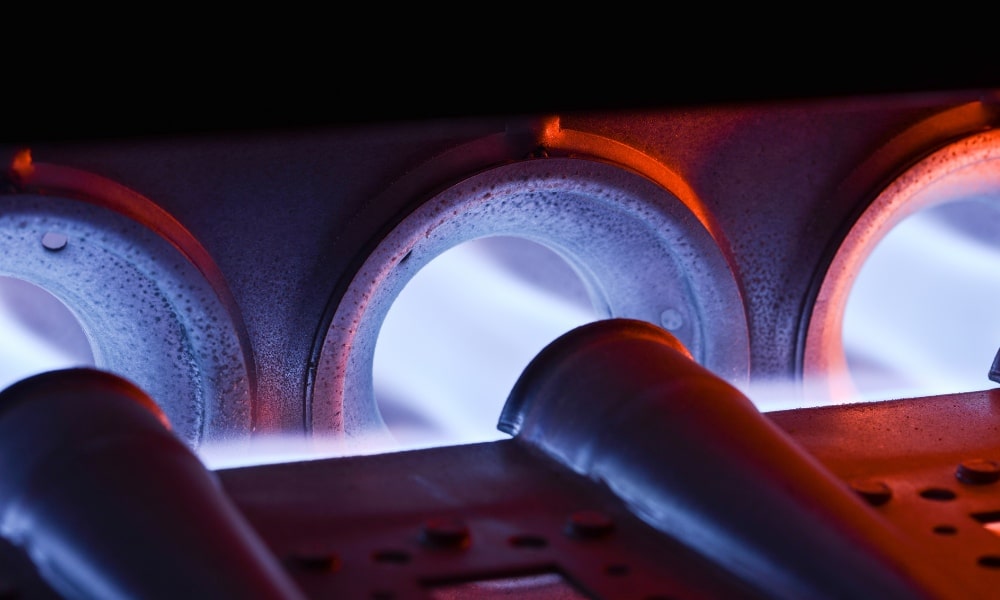A furnace burner is a critical component of a gas furnace, which helps heat your home. It works by igniting the fuel and releasing heat energy to warm the air circulating through your home. All furnaces that burn some fuel contain furnace burners.
A furnace burner is a device that generates heat from the fuel, which is typically natural gas or propane. It is designed to work with the furnace heat exchanger, which helps transfer heat from the burner to the air circulating throughout your home.

Understanding how a furnace burner works and how to maintain it is essential for homeowners who rely on a gas furnace to heat their homes.
How a Gas Furnace Burner Works?
Gas furnace burners use a gas valve to regulate gas flow into the burner. Once the gas enters the burner, it mixes with air and is ignited by a spark or pilot light. The resulting flame heats the heat exchanger, transferring the heat to the air circulating through your home.
The burner’s heat output is regulated by adjusting the amount of gas that enters the burner through the gas valve. The furnace’s thermostat monitors the temperature in your home and signals the gas valve to open or close to maintain the desired temperature.
Types of Furnace Burners
There are several furnace burners, each with unique features and applications. The most common types of furnace burners include:
Inshot Burner: Inshot burners are used within induced draft furnaces and are found in all new high-efficiency furnaces. Induced draft furnaces use a fan to create negative pressure in the heat exchanger, which pulls combustion gases through the exchanger and out the flue. The in-shot burner design ensures a stable and efficient flame, making it a popular choice for high-efficiency furnaces.
Upshot Burner: Upshot burners are typically used in natural draft furnaces. Natural draft furnaces are common in older furnaces and are slowly being replaced with high-efficiency gas furnaces. Upshot burners release flames that rise vertically, heating the heat exchanger from below.
Conversion Burner: Conversion burners are used when fuel is required to be converted from one type to another. For example, if you switch from oil to gas, you must replace the oil burner with a gas burner. Conversion burners are designed to be compatible with existing furnace equipment, making them a cost-effective solution for homeowners who want to switch to gas heating.
What type of burner do most modern furnaces use?
Most modern furnaces use in-shot burners, which are more efficient and environmentally friendly than other burner types. Inshot burners are designed to produce stable flames, which means they can operate at lower temperatures, reducing fuel consumption and operating costs. Additionally, in-shot burners produce fewer emissions, making them more environmentally friendly than other burner types.
Maintaining a Furnace Burner
Maintaining your furnace burner is critical to ensuring it operates efficiently and safely. Here are some tips for maintaining your furnace burner:
- Schedule annual maintenance: Regular maintenance can help detect and address any issues before they become major problems. Schedule annual maintenance with a professional HVAC technician to ensure your furnace burner and other components operate correctly.
- Keep the area around the furnace clean: Dust and debris can accumulate around your furnace, obstructing airflow and interfering with burner operation. Keep the area around your furnace clean and free from clutter to ensure proper airflow.
- Replace air filters regularly: Dirty air filters can restrict airflow, reducing furnace efficiency and putting additional strain on the burner. Replace air filters regularly to keep your furnace operating efficiently.
- Check the pilot light: If your furnace has a pilot light, check it regularly to ensure it burns steadily. A flickering pilot light can indicate an issue with the burner, such as a dirty or faulty sensor. If you notice any issues with the pilot light, contact a professional HVAC technician for assistance.
- Check for signs of wear and tear: Furnace burners can become worn over time and may need replacement. Check the burner for signs of rust or corrosion and any cracks or other damage. If you notice any signs of wear and tear, the burner might need to be replaced.
Follow the manufacturer’s instructions for your furnace, including any maintenance or operation instructions. Following these instructions can help prevent damage to your furnace and ensure it operates safely and efficiently.
A furnace burner is an essential gas furnace component responsible for heating the air circulating throughout your home. Understanding how furnace burners work and how to maintain them is crucial for homeowners who rely on a gas furnaces to heat their homes. By following proper maintenance procedures and seeking professional assistance when necessary, you can keep your furnace operating safely and efficiently for years.






